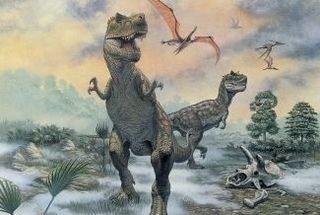The Biggest Carnivore: Dinosaur History Rewritten

The Age of Dinosaurs ended millions of years ago but paleontologists are still attempting to get a handle on the immense diversity and diverse immensity of these creatures.
Take the report last month that Spinosaurus is now officially the biggest carnivorous dinosaur known to science. This two-legged beast actually strode onto the fossil scene in 1915 when a specimen was described by German paleontologist Ernst Stromer. He figured this theropod (defined as a two-legged carnivore) was bigger than Tyrannosaurus rex, but the original Spinosaurus bones were destroyed by Allied bombs in 1944. So the T. rex reigned as the king size, carnivorous land beast for decades.
Then along came Giganotosaurus 11 years ago.
Now Cristiano Dal Sasso of the Civil Natural History Museum in Milan says Giganotosaurus has been dethroned based on estimates from a new Spinosaurus skull.
So just how do all these carnivores match up?
Tyrannosaurus rex
Giganotosaurus
Sign up for the Live Science daily newsletter now
Get the world’s most fascinating discoveries delivered straight to your inbox.
Spinosaurus
For the ultimate in dinosaur length though, a vegetarian diet prevailed. Herbivorous sauropods dwarfed carnivorous theropod dinosaurs, and most scientists think Argentinasaurus was the longest of all dinosaurs.
Argentinasaurus
Paleontologists have only fossils to compare dinosaur sizes, and those fossils are often damaged or incomplete. The same bone from numerous specimens is often lacking, so scientists often must estimate the total size of an animal from a partial skeleton, as with the new Spinosaurus skull fragments.
Greg Erickson of Florida State University says mass, not length, is the best standard for comparing dinosaur size because it gets around the problem of differently shaped animals. Mass is best estimated, he said, by measuring the circumference of the thighbone, which bears much of the animal's weight.
The new Spinosaurus size estimate is "compelling," Erickson told LiveScience. "Spinosaurus was probably considerably longer, and hence perhaps heavier, than T. rex and other large theropods."
- Gallery: Dinosaur Fossils
- Dinosaurs that Learned to Fly
- A Brief History of Dinosaurs
Robin Lloyd was a senior editor at Space.com and Live Science from 2007 to 2009. She holds a B.A. degree in sociology from Smith College and a Ph.D. and M.A. degree in sociology from the University of California at Santa Barbara. She is currently a freelance science writer based in New York City and a contributing editor at Scientific American, as well as an adjunct professor at New York University's Science, Health and Environmental Reporting Program.

